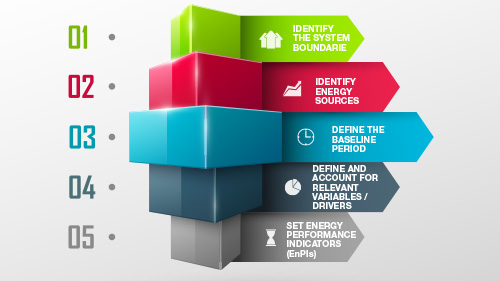One of the biggest challenges to effectively managing energy is to accurately determining an energy management system’s impact on energy use and cost. For an industrial organization to demonstrate improvements in energy performance, the organization has to set an energy consumption baseline. An energy baseline is a reference tool that allows the organization to compare energy performance before and after a change is made to your site or system. The baseline establishes the “before” by capturing a site or system’s total energy use prior to making improvements. Without an accurate baseline, the effectiveness of an energy management system (EnMS) cannot be monitored and hence corrective actions and improvements cannot be
identified or implemented.
Developing an accurate baseline is not always straightforward. Whatever the method used for the development of a baseline is, it has to discriminate
changes in consumption caused by energy efficiency (EE) measures from changes caused by relevant variables (e.g. weather, production, product mix, etc.). These factors can cause variations that mask the effects one is trying to detect and quantify. Simple baseline development approaches usually have some degree of inaccuracy that can make them misleading, while rigorous and reliable approaches are sometimes more complex than the natural comfort level of most facility managers.
There are many approaches for establishing an Energy Baseline but they all follow the same five key concepts that govern EnMS. There are many steps that any organization should follow in order to establish its own Baseline. (1) The organization has to first identify the system boundaries, (2) then they shall identify the energy sources and (3) define the baseline period. Although the former steps might present some challenges for an
organization but they are more or less considered as the simple part in comparison to the later steps. Followed by these steps, the organization has to (4) define and account for relevant variables/drivers and (5) set energy performance indicators (EnPIs).
The main challenge is faced in the fourth step when accounting for the different variables affecting the baseline. In many cases, this is sometimes due to lack of readily available reliable and accurate data. Also when setting EnPIs, sometimes energy managers face internal resistance from the organization to change the standard organization/sector EnPIs, for example in the cement industry specific energy consumption is the “standard”
EnPI. In many cases, SEC (or any other simple ratio) is deceiving or misguiding especially where other factors are actually affecting the energy performance or when the organization experiences high baseloads.
The bottom line is that setting an accurate baseline could present the most challenging step in the Planning Stage of an EnMS. However, an inaccurate baseline could forfeit the main benefits of an EnMS and could mislead an organization in assessing their energy performance and hence in measuring the impact of EE measures and interventions.
